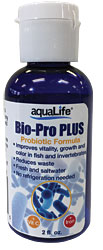6. How to Choose and Feed Freshwater Aquarium Fish
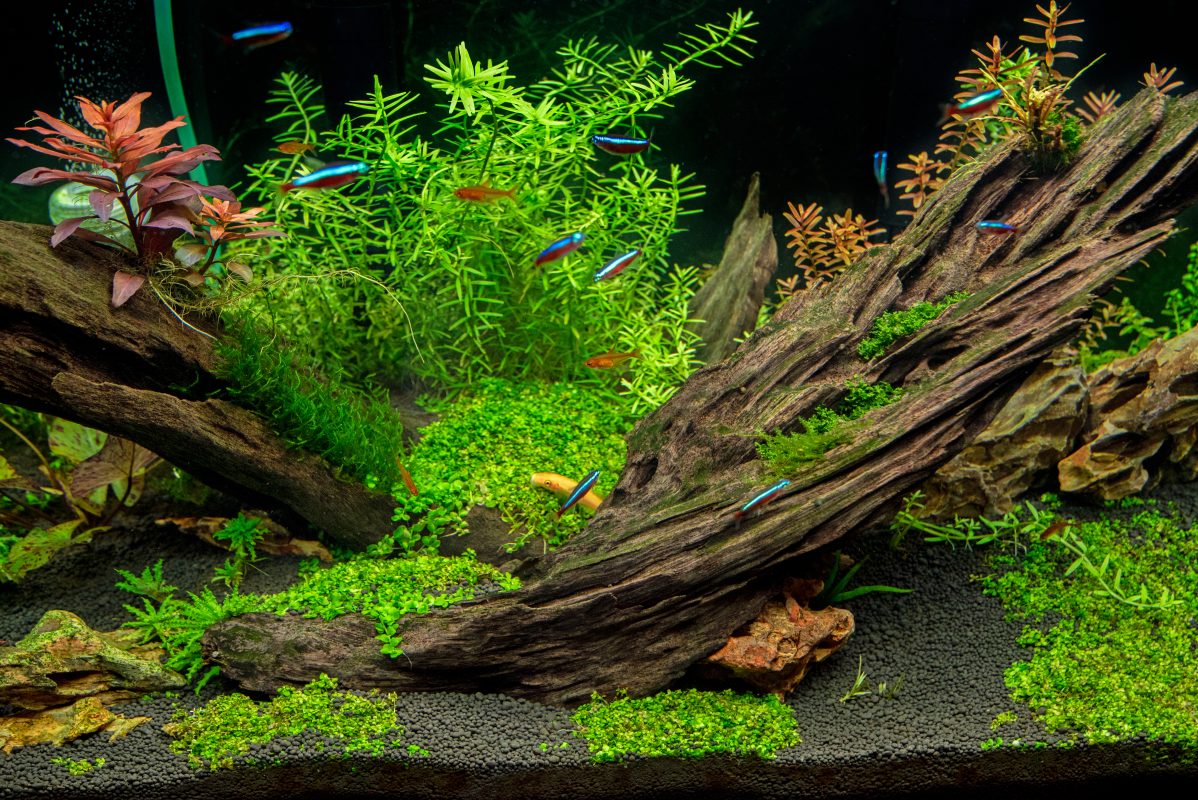
General guidelines for feeding freshwater fish
Learning how to choose the proper diet and feed freshwater aquarium fish is important. How often and when to feed fish varies from tank to tank depending on its inhabitants. Different types of fish have different feeding habits and nutrition requirements. Learn how to choose the proper brand and diet for the long term health of your pets.
Carnivores have larger stomachs and tend to gulp larger quantities of food once a day and some only 3 times a week. Herbivores have small stomachs and longer intestines and feed here and there throughout the day. Omnivorous fish, some of which are active at night, spend the day hunting for food. In a community tank, feed twice a day and only what the fish consume within 5 minutes.
Feeding a variety of foods, including flake, frozen, freeze dried and live foods, ensures that fish get the balance of nutrients they require and the ingredients most likely will match some of the foods they eat in their natural habitats. Also, adding BioPro Plus probiotic supplement with added iron and Vitamin C, Hyper Garlic, and Vita-Chem to freeze dried and pellet foods improves fish health and stimulates the immune systems of most species.
Learning more about advanced nutrition and the brands that are best
To learn more about fish feed and nutrition see this great primer article by biologist John Tullock from www.aqualiferx.com. After over 40 years of feeding and breeding fish we can say that all brands are not equal. Most of the lines in mass merchants do not offer the quality or freshness that more specialized brands offer. Feeding more frozen is always preferred to the dry products when possible. The companies we trust and recommend above other lines are www.aquaLiferx.com, Sera, Bay Brand, Ocean Nutrition, Azoo, and New Life Spectrum. Do some of the other lines have a good product in their mix? Sure they do. But we keep going back to these because they offer better results, growth, color and long term health for our fish over all.

Characins
Most characins are active in the day and travel in schools. Tetras are included in the group. Examples: Pristella Tetra (Pristella maxillaris), Cardinal Tetra (Paracheirodon axelrodi), Rummynose Tetra (Hemigrammus bleheri). Members of this group that have red, orange or gold colorations can be brightened by supplementing the Vivid Color Flake. Freeze dried blood worms soaked in vitamins, Vita Chem Freshwater or frozen bloodworms should be included as a treat to maximize growth and health.
Feed a combination of:
• AquaLife CSPro Flake with Calanus & Spirulina
• sera san Color Enhancing Flakes
Supplementing with these 2-4 times a week:
• Freeze Dried Blood Worms
• Frozen Baby Brine Shrimp
• Frozen Bloodworms

Livebearers
This is one group of fish that shows off its splendor when fed a healthy, varied diet. Quality color enhancers combined with a diet heavy in Sprirulina make a huge difference in the long term health and vitality of these fish. Mollies, in particular, should be fed Spirulina. The secret to healthy Swordtails is a varied diet. Color enhancers and bloodworms make the most difference in Platys. Examples: Guppies (Poecillia reticulata), Black Molly (Poecillia latipinna), Swordtail (Xiphophorus helleri), and Platy (Xiphophorus macalatus).
Feed a combination of:
• AquaLife CSPro Flake with Calanus & Spirulina
• aquaLife Spirulina Flake
• Frozen Brine Shrimp or Spirulina Brineshrimp
• Frozen Bloodworms

Catfish
This group includes many night feeders and does best when fed diets specific to each species. Remember, the difference between healthy and dying Plecos is Spirulina wafers and driftwood for them to feed on. Cory cats, as well as other species in this group, sift through gravel and scavenge for uneaten food. Examples: Cory cats, Plecos, Pictus Cat (Pimelodus pictus).
Feed a combination of:
• CS Pro Small Sinking Sticks Calanus & Spirulina
• sera viformo Sinking Tablets or VipaChips
• Frozen Bloodworms
• Frozen Emerald Entree

Plecostomus
Plecostomus need some driftwood in the tank and food high in vegetable matter in a sinking form.
In addition to the foods mentioned above, Frozen Emerald Entree and catfish foods from sera with wood is the best way to feed these fish along with AquaLife Pleco Discs. These are rich in algae and stay hard longer so the can grind on them like they feed in nature.

Loaches
These are aquarium favorites, and include Clown Loaches, Redtail Sharks (Epalzeorhynchus bicolor), Zipper Loaches (Botia fasciata) and many more. Clown Loaches (Botia macracanthus) and other loaches grow large and colorful with the right combinations of nutritious foods.
Feed a combination of:
• CS Pro Small Sinking Sticks Calanus & Spirulina
• sera VipaChips
• Frozen Bloodworms
• Live Blackworms, if available. We have them at our local facility.

Barbs
Some members of this active and interesting family are fin nippers and should be kept in schools of 5 or more to minimize aggressive behavior. All Barbs grow healthy and full with Vivid Color Flakes for color enhancing and brine shrimp treats. Examples: Tiger Barb (Barbus tetrazona), Tinfoil (Barbus schwanefeldi) and Cherry Barbs (Barbus titteya).
Feed a combination of:
• AquaLife CSPro Flake with Calanus & Spirulina
• sera vipan Flakes
Supplementing with these 2-3 times a week:
• Frozen Brine Shrimp
• Frozen Bloodworms

Rainbows
Many species of Rainbow fish are available for the home aquarium. Examples: Boesemani Rainbow Fish (Melantaenia boesemani). Proper feeding with quality, nutritious foods helps make this of the most exciting and colorful fish available for the community aquarium. As they grow larger, introduce them to pelleted food like New Life Spectrum Foods.
Feed a combination of:
• AquaLife CSPro Flake with Calanus & Spirulina
• sera vipan Flakes
Supplementing with these 2-3 times a week:
• Frozen Brine Shrimp
• Frozen Bloodworms

Carp-Like Fish
This group is characterized by its sucker-type mouth. Most members of the group feed on algae but also delight in a frequent meaty treat. Example: Chinese Algae Eater (Gyrinocheilus aymonieri).
Feed a combination of:
• CS Pro Small Sinking Sticks Calanus & Spirulina
• sera viformo Sinking Tablets or VipaChips

African Cichlids
Color and intensity are what these fish bring to an aquarium. Hardiness, striking color, morphology and unique behaviors make this one of the most interesting groups for the home or office aquarium. Feeding twice daily, once with frozen and once with other foods is recommended. Examples: T Electric Blue Johannii (Melanochromis johannii), Cobalt Blue Cichlid or Zebra Malawi Cichlid (Pseudotropheus zebra), Auratus (Melanochromis auratus), Labidochromis (Labidochromis caeruleus “yellow”), Pseudotropheus (Pseudotropheus socolofi) and Frontosa (Cyphotilapia frontosa).
Feed a combination of:
• CS Pro Large Sinking Sticks and Flake with Calanus & Spirulina
• sera Granules for African Cichlids
• New Life Pellet Food
Second Feeding with Frozen Food or at least with these 2-4 times a week:
• Frozen Plankton
• Frozen Bloodworms
• Frozen Emerald Entree

Other Cichlids
These fish very do well on flakes and small pellets when young. As they grow and become fuller, introduce larger foods like frozen, freeze dried and pellets. Color enhancing foods bring out red, yellow and orange colorations. Feed frozen instead of live food because bones from feeder fish are not easily digested. Proper nutrition keeps these fish healthy and robust for many years. Examples: Oscars (Astronotus occellatus), Red Devil Cichlid (Amphilophus labiatus), Firemouth Cichlid (Thorichthys meeki), Dempseys (Nandopsis octofasciatus), Blood Parrot Cichlids (Amphilophus “Red Parrot” hybrid).
Feed a combination of:
• CS Pro Large Sinking Sticks with Calanus & Spirulina
• sera Cichlid Sticks
• New Life Pellet Food
• Azoo Cichlid Sticks
• Frozen and Freeze Dried Krill
• Frozen Plankton
• Frozen Silversides

Angelfish
These graceful cichlids can be picky eaters and sometimes difficult to feed. The foods listed below contain all the nutrition for daily activity, reproductive cycles and caring for fry.
Feed a combination of:
• aquaLife CSPro Flake with Calanus & Spirulina
• Variety Frozen Food
Supplementing with these 2-3 times a week:
• Frozen Brine Shrimp
• Frozen Bloodworms

Gouramis
Gouramis are a group of freshwater anabantiform fishes that comprise the family Osphronemidae. The fish are native to Asia—from Pakistan and India to Southeast Asia and northeasterly towards Korea. The name “gourami”, of Indonesian origin, is also used for fish of the families Helostomatidae and Anabantidae. Many gouramis have an elongated, feeler-like ray at the front of each of their pelvic fins. All living species show parental care: some are mouthbrooders, and others, like the Siamese fighting fish (Betta splendens), build bubble nests.
Feed a combination of:
• aquaLife CSPro Flake with Calanus & Spirulina
• sera vipan Flakes
• aquaLife Vivid Color Flakes
Supplementing with these 2-3 times a week:
• Frozen Brine Shrimp
• Frozen Bloodworms

Discus
Discus people know what they want. They simply look for the best looking, most exotic fish in freshwater. Keeping these fish is a little challenging. Nutrition is the first step in reducing the challenge. An all-frozen diet is the best choice for these fish. Some keepers have good luck with dried foods. The pros use the foods listed below.
Feed a combination of:
• AquaLife CSPro Flake with Calanus & Spirulina
• sera discus granules
• sera discus color Blue
• Frozen Bloodworms
• Live Blackworms, if available. We have them in our local facility

Betta Fish
Bettas (Betta splendens)
First discovered in Southeast Asia in rice paddies, drainage ditches and the warm flood plains of the region, the betta became accustomed to frequent storm flooding and devastating droughts. The cyclic, drastic changes in its environment helped the fish to adapt – becoming a true labyrinth fish having unique ability to breathe oxygen directly from the air and also take in oxygen from its gills. As a result, bettas and other labyrinth fish can survive for short periods of time out of water and if needed, can inhale the air around them (provided they stay moist.) This also explains why a betta can sustain itself in stagnant, oxygen-deficient water. Bettas have upturned mouths and primarily feed on the water’s surface.
Feed a combination of:
• sera bettagran
• Atison’s Betta Food or Azoo Betta Cuisine
• Freeze Dried Bloodworms
Supplementing with these 2-3 times a week:
• Frozen Bloodworms
• Live Blackworms, if available. We have them in our local facility.

Goldfish
The goldfish (Carassius auratus) is a freshwater fish in the family Cyprinidae of order Cypriniformes. It is commonly kept as a pet in indoor aquariums, and is one of the most popular aquarium fish. Goldfish released into the wild have become an invasive pest in parts of North America. Native to East Asia, the goldfish is a relatively small member of the carp family (which also includes the Prussian carp and the crucian carp). It was first selectively bred for color in imperial China more than 1,000 years ago, and several distinct breeds have since been developed.
In the wild, the diet of goldfish consists of crustaceans, insects, and various plant matter. Like most fish, the are opportunistic feeders and do not stop eating on their own accord. Overfeeding can be deleterious to their health, typically by blocking the intestines. Do not overfeed.
Feed a combination of:
• AquaLife CSPro Flake with Calanus & Spirulina
• CS Pro Small Sinking Sticks Calanus & Spirulina
• sera Goldy or aquaLife Goldfish Flake
Supplementing with these 2-3 times a week:
• Frozen Emerald Entree

Koi
Koi, or more specifically nishikigoi, are colored varieties of the Amur carp (Cyprinus rubrofuscus) that are kept for decorative purposes in outdoor koi ponds or water gardens. Koi is an informal name for the colored variants of C. rubrofuscus kept for ornamental purposes. There are many varieties of ornamental koi, originating from breeding that began in Niigata, Japan in the early 19th century. Several varieties are recognized by the Japanese, distinguished by coloration, patterning, and scalation.
The bright colors of koi put them at a severe disadvantage against predators. Herons, kingfishers, otters, raccoons, mink, cats, foxes, badgers, and hedgehogs are all capable of emptying a pond of its fish. For more on feeding your pond fish see this solution.
Koi are omnivorous fish and eat a wide variety of foods.
Feed a combination of: Koi Select by aquaLife is an all season formula food that contains the clay and all the vital nutrients fish need. Refill programs are available of the great small batch food. Small batch limited production insures quality nutrition that will keep you pond fish healthy while helping them live longer with better color.
Koi Select ASF Premium Koi Food, small pellet
Koi Select ASF Premium Koi Food, medium pellet
-
 2 lb Medium Koi Select ASF Premium Koi Food Med$15.74
2 lb Medium Koi Select ASF Premium Koi Food Med$15.74 -
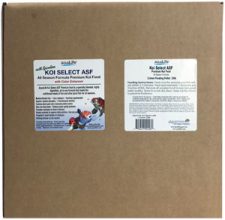 25 lb Medium Koi Select ASF Premium Koi Food$178.49
25 lb Medium Koi Select ASF Premium Koi Food$178.49 -
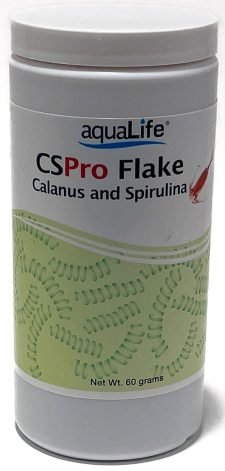 CS Pro Flake Calanus & Spirulina – 60 grams$13.64
CS Pro Flake Calanus & Spirulina – 60 grams$13.64 -
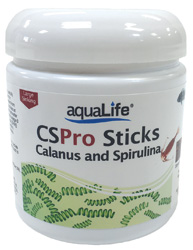 CS Pro Large Sinking Sticks Calanus & Spirulina Food 5 oz$13.64
CS Pro Large Sinking Sticks Calanus & Spirulina Food 5 oz$13.64 -
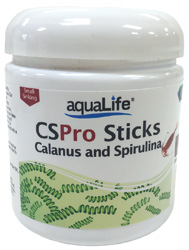 CS Pro Small Sinking Sticks Calanus & Spirulina Food 4 oz$13.64
CS Pro Small Sinking Sticks Calanus & Spirulina Food 4 oz$13.64 -
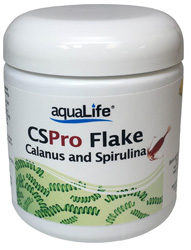 CS Pro Flake Calanus & Spirulina Food 25 gram$8.39
CS Pro Flake Calanus & Spirulina Food 25 gram$8.39

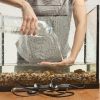 Setting Up An Aquarium – 16 Basic Steps
Setting Up An Aquarium – 16 Basic Steps

